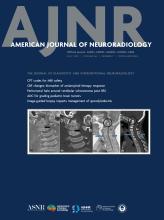Case of the Week
Section Editors: Matylda Machnowska1 and Anvita Pauranik2
1University of Toronto, Toronto, Ontario, Canada
2BC Children's Hospital, University of British Columbia, Vancouver, British Columbia, Canada
Sign up to receive an email alert when a new Case of the Week is posted.
September 3, 2020
Petrous Apex Chondrosarcoma in Ollier Disease (Enchondromatosis)
- Background:
- Enchondromatosis is rare, estimated to affect 1 in 100,000.
- Chondrosarcomas are more common in the skull base than their benign counterpart, chondromas. Chondrosarcomas of the petrous apex arise from the petroclival and petrosphenoid synchondroses.
- Patients with Ollier disease, Maffucci syndrome (enchondromatosis + hemangiomatosis), and Paget disease are at increased risk of chondrosarcoma.
- While the pathogenesis is uncertain, it has been hypothesized that multiple enchondromas arise from sporadic mutations in isocitrate dehydrogenase-1 and -2 genes or the parathyroid hormone–related protein receptor gene, leading to abnormalities in the differentiation and proliferation of chondrocytes.
- Clinical Presentation:
- Enchondromatosis often presents in childhood with a palpable bony mass, pathologic fractures, or limp due to limb-length discrepancy.
- Lesions of the petrous apex may result in CN VI palsy, involving CN VI as it passes through Dorello canal in the petrous apex.
- Key Diagnostic Features:
-
Chondrosarcomas are heterogeneous tumors with a chondroid matrix on CT and T2 hyperintensity on MRI. They are usually T1 isointense to hypointense. Enhancement is variable.
-
On radiograph and CT, enchondromas are well-circumscribed, lucent lesions seen near the physis of long bones, particularly the hands and feet. A ring-and-arc pattern of cartilage calcification and mild endosteal scalloping may be observed, but hand enchondromas often lack these features.
-
In the presence of enchondromatosis, a T2-hyperintense petrous apex lesion is most likely a chondrosarcoma, as in our case, which was a pathology-proven chondrosarcoma.
-
- Differential Diagnoses:
- Chordoma (also T2 hyperintense with enhancement but is more often centered in the midline of the clivus vs. chondrosarcoma which is lateral)
- Chondroblastoma (also T2 hyperintense with chondroid matrix, much more rare)
- Epidermoid (homogeneously T2 hyperintense and restricts diffusion)
- Cholesterol granuloma (both T1 and T2 hyperintense)
- Treatment:
- Surgical resection is challenging due to the location of the petrous apex.
- Gross total resection is the best chance for cure but must be weighed against potential functional deficits and the tumor grade. Radiation may also reduce the risk of recurrence.











